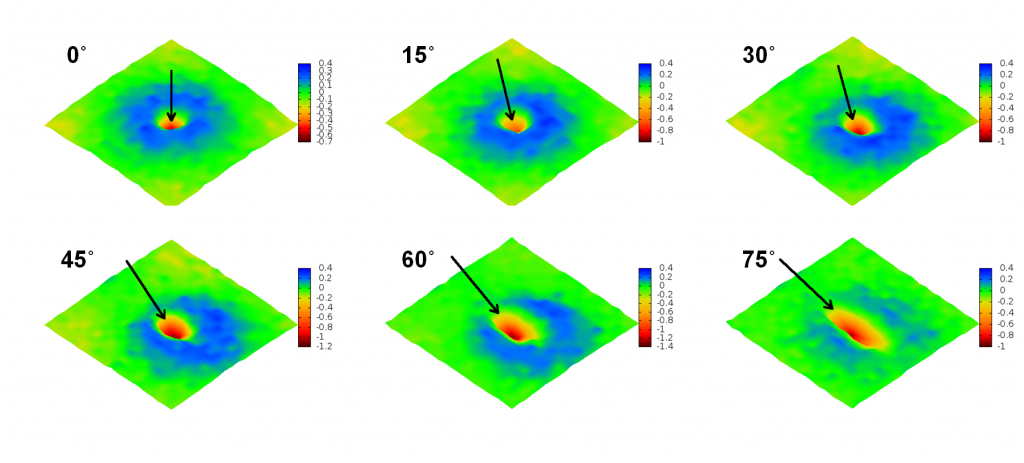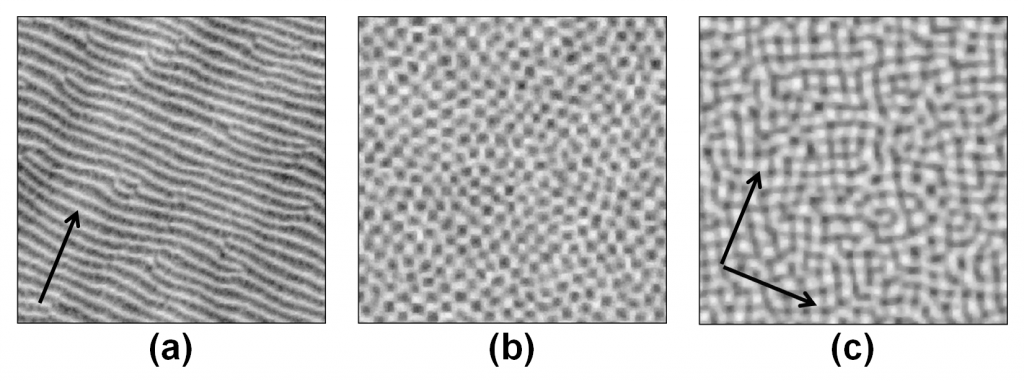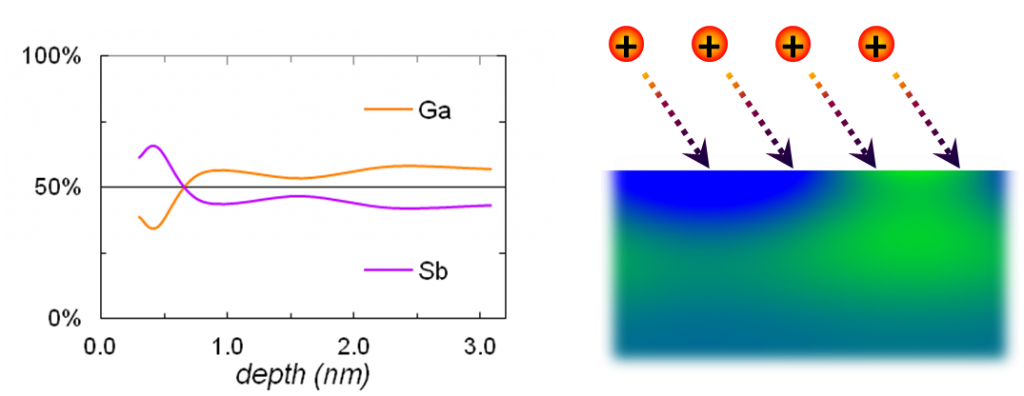Multi-Scale Computational Irradiation Surface Science
Developing a multiscale atomistic model of self-organized nanopattern formation induced by ion beam sputtering
Various self-organized patterns can be induced by ion beam sputtering (IBS), including ripples and quantum dots. Our group has developed a hybrid MD/kMC (Molecular Dynamics/kinetic Monte Carlo) multiscale atomistic model to model the evolution of these nanostructures. This model uses crater functions, which are obtained by MD simulations, to model the surface response to single-ion impacts. The crater functions have the advantage of considering all relevant mechanisms that could affect the surface evolution, including ion-induced surface mass redistribution and the sputtering of surface atoms. The surface relaxation, which counteracts the ion-induced instabilities, is modeled by either a kinetic Monte Carlo (kMC) model of surface defect mobility or ion-enhanced viscous flow using numerical methods.
Crater functions for 500 eV Ar+ bombardment of Si, demonstrating how the surface response to single-ion impacts varies as the incidence angle changes.
Highlight: Ripple coarsening and propagation, sample rotation, dual-beam sputtering
Our model is capable of mimicking real experimental processes, and can reproduce experimental results with good qualitative agreement, e.g. for Ar+ bombardment of Si. Furthermore, our model can consider novel experimental setups that cannot be treated effectively by other models, such as dual beam patterning or patterning during sample rotation.
Simulated surfaces obtained from the model, showing the results of 500 eV Ar+ bombardment of Si for 60° incidence with (a) no unique setup, (b) sample rotation during bombardment, and (c) dual-beam bombardment (at 65°).
Our model reveals that the formation of ripples occurs in several stages. For early stages (low fluence), very small ripple-like structures are formed locally, serving as “ripple seeds”. With increasing fluence, clear ripples that develop from the “ripple seeds” become to appear. As bombardment continues the amplitude of the ripples starts to grow larger while the wavelength remains nearly constant. At around 1016 cm-2, the wavelength of the ripples also starts to grow larger, indicating the start of coarsening. This stage is characterized by an intriguing mechanism wherein the prompt redistributive effect from the ion impacts pushes material onto the edge of the ripples, causing them to grow laterally. As the ripples elongate, they “run into” each other, leading to a reduction in the pattern defect density. The amplitude and wavelength of the ripples finally saturate at around 1017 cm-2.
Animation of successive frames output from our model during simulated 500 eV Ar+ bombardment of Si at 60°. Note the observable lateral growth of the ripples in the mid-late stages of the pattern evolution due to mass redistribution near the edge of the ripples.
Highlight: Modeling nano-patterning of multicomponent systems: ion-driven compositional phase dynamics on III-V semiconductor surfaces
In its current state, our model is adequate for simulation of single-element targets. However, when multiple species are present in the target surface, the energy impartation from the ions could induce thermodynamic effects that drive three-dimensional compositional gradients, leading to new phase-driven instabilities that could dominate the “traditional” kinetic mechanisms that determine single-component surface morphology. In addition to lateral phase separation along the surface due to preferential redistribution and/or erosion of the surface components, recent experimental work has also found a variable compositional depth profile which evolves as bombardment proceeds, which may play a key role in determining the surface morphology.
LEFT: Convoluted depth profile of a GaSb surface bombarded with Kr+ ions to a fluence just at the pattern formation threshold. RIGHT: Illustrative depiction of the surface compositional gradient in a binary material, showing both lateral and depth variations in the relative concentration of each element.
To investigate these intriguing new mechanisms, our group will take advantage of the computational resources available at UIUC, such as Blue Waters and XSEDE, to conduct fundamental investigations of these processes using MD simulations. The crater function concept can be extended to multicomponent systems to study not only the surface response to single-ion impacts, but also how that response varies as the compositional profile evolves. Additionally, the extreme environment of Blue Waters enables large-scale MD simulations, over length scales of the order ~102 nm and several thousand ion impacts, in order to identify the key ion-driven compositional mechanisms that lead to nanostructure formation on these kinds of surfaces.
Selected Publications
Z. Yang, M.A. Lively, J.P. Allain, “Kinetic Monte Carlo simulation of self-organized pattern formation induced by ion beam sputtering using crater functions”, Phys. Rev. B 91, 075427 (2015).
Zhangcan Yang, Mike Lively, and Jean Paul Allain, Atomistic simulation of ion beam patterning with crater functions, Nucl. Instrum. Meth. B, 2013 vol. 307 pp. 189-193
People
Collaborators
Southern Methodist University
Stony Brook University
University of Tennessee
National Center for Supercomputing Applications.


